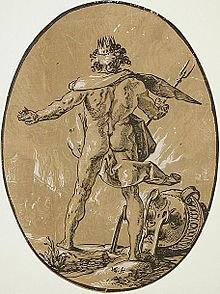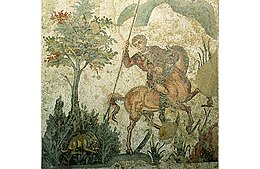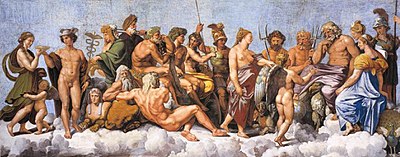Bident

A bident is a two-pronged implement resembling a pitchfork. In Greek mythology, the bident is a weapon associated with Hades (Pluto), the ruler of the underworld.
Likewise, the three-pronged
Etymology
The word 'bident' was brought into the English language before 1871,[1] and is derived from the Latin bidentis, meaning "having two teeth (or prongs)."[2]
Historical uses
Ancient Egyptians used a bident as a fishing tool, sometimes attached to a line and sometimes fastened with flight feathers.[3] Two-pronged weapons mainly of bronze appear in the archaeological record of ancient Greece.[4]
In
In mythology

The spear of
A bronze trident found in an Etruscan tomb at
The
The later notion that the ruler of the underworld wielded a trident or bident can perhaps be traced to a line in the
In art

In
Perhaps influenced by this work, Agostino Carracci had depicted Pluto with a bident in a preparatory drawing for his painting Pluto (1592), in which the god holds instead his characteristic key.[25]
In Caravaggio's Giove, Nettuno e Plutone (ca. 1597), a ceiling mural based on alchemical allegory, Pluto – with his 3-headed dog, Cerberus – holds a bident. (Immediately beside him, Neptune is shown with a trident. Some writers have confused the two figures; Neptune's identity is confirmed by his embrace of the Hippocamp – the "sea horse" with fins for forelegs, and whose markings appear to repeat the trident in a stylized, perhaps symbolic, form.)
See also
References
- ^ "Bident". The Cabinet Dictionary of the English Language. Glasgow: William Collins, Sons, and Company. 1871. p. 56.
- ^ American Psychological Association (APA). "Webster's Revised Unabridged Dictionary". Dictionary.com. www.reference.com. Archived from the original on July 31, 2012. Retrieved May 18, 2012.
- ^ Wilkinson, John Gardner (1837). Manners and customs of the ancient Egyptians: including their private life, government, laws, arts, manufacturers, religion and early history : derived from a comparison of the painting, sculptures and monuments still existing with the accounts of ancient authors, Volume 3. Murray. pp. 60, 61.
bident was a spear with two barbed points ... thrust at the fish ... fish spears of the South Sea Islanders ... same manner ... as the bident by the ancient Egyptians
- ^ Arthur Bernard Cook, Zeus: A Study in Ancient Religion (Oxford University Press, 1924), vol. 2, p. 799.
- ^ K.D. White, Roman Farming (Cornell University Press, 1970), p. 239.
- ^ K.D. White, Agricultural Implements of the Roman World (Cambridge University Press, 1967, 2010), p. 11.
- ^ White, Agricultural Implements, p. 12.
- ^ Pliny, Natural History 17.54; White, Agricultural Implements, p. 19.
- ^ White, Agricultural Implements, pp. vii, viii, 11, 51.
- scholiast to Pindar, Nemean Ode 6.85 and the scholiast to the Iliad 16.142. Also in the Classical period by Aeschylus in the fragmentary Nereids (Nereides), frg. 152 in the second edition of Nauck; and by Sophoclesin the Lovers of Achilles (Achilleos erastai), frg. 156 (Nauck2 = 152 in the edition of Jebb), as cited by Cook, Zeus, vol. 2, p. 799.
- ^ Cook, Zeus, vol. 2, p. 799.
- ^ Cook, Zeus, vol. 2, pt. 2, p. 1225, with images of Zeus wielding lightning bolts, and citing Milani, Studi e materiali di archeologia e numismatica (Florence, 1905), (vol. 3, p. 85.
- ^ Cook, Zeus, vol. 2, pp. 800–801. The kylix from the workshop of Brygos.
- ^ Cook, Zeus, vol. 2, p. 801.
- ^ Cook, Zeus, vol. 2, p. 802.
- ^ Cook, Zeus, vol. 2, pp. 805–806.
- ^ Cook, Zeus, vol. 2, p. 803, with image on p. 804.
- ^ Cook, Zeus, vol. 2, p. 806.
- genitive case), Hercules Furens line 47, in the prologue spoken by Juno.
- ^ Diro Iovi, line 608 of Hercules Furens; compare Vergil, Aeneid 4.638, Iove Stygio, the "Jove of the Styx". Fitch, Seneca's Hercules Furens, p. 156.
- Phoenician Women, line 188, as cited by Cook, Zeus, vol. 2, p. 806, note 6.
- ^ Cook, Zeus, vol. 2, p. 803.
- ^ Friedrich Solmsen, "The Powers of Darkness in Prudentius' Contra Symmachum: A Study of His Poetic Imagination," Vigiliae Christianae 19.4 (1965), pp. 238, 240–248 et passim.
- ^ Richard Stemp, The Secret Language of the Renaissance: Decoding the Hidden Symbolism of Italian Art (Duncan Baird, 2006), p. 114; Clare Robertson et al., Drawings by the Carracci from British Collections (Ashmolean Museum, 1996), p. 78.
- ^ Robertson et al., Drawings by the Carracci from British Collections, pp. 78–79.
External links
![]() Media related to Bidents at Wikimedia Commons
Media related to Bidents at Wikimedia Commons
